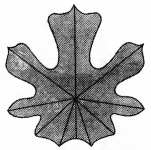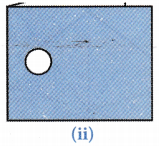What is the Definition of Symmetry in Maths
Symmetry is an important geometrical concept commonly seen in nature and is used in every field of our life. Artists, manufacturers, designers, architects, and others make use of the idea of symmetry. Leaves, flowers, clothes, mats, handkerchiefs, utensils have symmetrical designs.
Symmetry is the balanced distribution of duplicate shapes. Literally, the word ‘symmetry’ means allowing an object to be divided into two equal parts such that one part coincides with the other.
If we look at plants and animals, we find that they have symmetrical body parts or shapes.
 Look at the leaf, if we divide the leaf in half, we often find that one half has the same shape as the other half. Symmetry exists all around us and many people see it as being a thing of beauty.
Look at the leaf, if we divide the leaf in half, we often find that one half has the same shape as the other half. Symmetry exists all around us and many people see it as being a thing of beauty.
 Butterflies and moths are symmetrical, they have two equal sides. Look closely at a butterfly or moth. See the patterns of colour and designs in their wings. Do we find symmetry?
Butterflies and moths are symmetrical, they have two equal sides. Look closely at a butterfly or moth. See the patterns of colour and designs in their wings. Do we find symmetry?
 Leonardo da Vinci shows symmetry in the human body. Can you think of examples of symmetry inside the body? The examples are the kidneys, the brain, and the skull, etc.
Leonardo da Vinci shows symmetry in the human body. Can you think of examples of symmetry inside the body? The examples are the kidneys, the brain, and the skull, etc.
There are certain objects which are not symmetrical like stone, few English alphabets (e.g., F, G, J, etc.), etc.
Since childhood, we are dealing with English alphabets. Have you noticed something about the letters:
 The letters B, D, H, and I are symmetrical. They are horizontally symmetrical. The letter A is also symmetrical but it is vertically symmetrical. Here the letter P is not symmetrical.
The letters B, D, H, and I are symmetrical. They are horizontally symmetrical. The letter A is also symmetrical but it is vertically symmetrical. Here the letter P is not symmetrical.
When we look around in our neighbourhood, we find many shapes and figures which are evenly balanced and in perfect proportion.
Let us play a game called “Punch a Hole”
Step 1: Take a sheet of paper and fold it into two halves.
 Step 2: Punch a hole.
Step 2: Punch a hole.
 Step 3: Open the sheet, the holes are symmetric about the fold.
Step 3: Open the sheet, the holes are symmetric about the fold.

